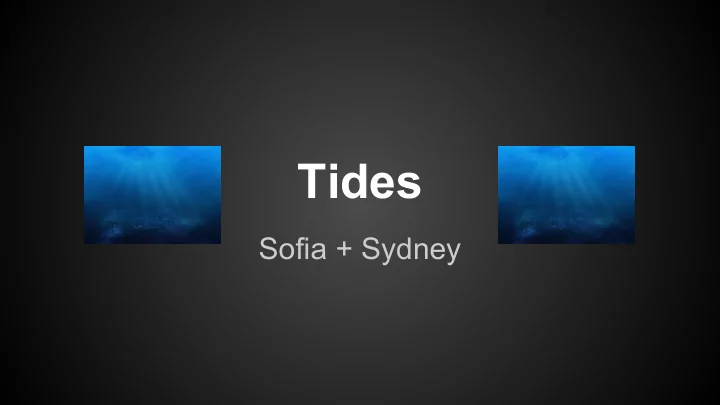

Tides Sofia + Sydney
Intro - tide = movement in the ocean - high tide = when the water is at its highest point - low tide = when the water is at its lowest point - controlled by the moon the water in this picture is controlled by tides →
Tidal Cycles - 1 high tide and 1 low tide are in each cycle - According to WorldBook, “Earth takes about 24 hours and 50 minutes to complete one rotation with respect to the moon.” So, how long do you think one tidal cycle takes?
Tidal Cycles - continued - each tidal cycle lasts for 12 hours and 25 minutes. http://upload.wikimedia. org/wikipedia/commons/3/37/Clock.gif
High Tide + Low Tide Here are two pictures of the same beach at low tide and high tide (about 6 hours apart)
Equilibrium Tide - moon has different pull on different parts of ocean - tides aren’t in the perfect shape - but if they WERE: - the part of ocean nearest to the moon is bulging towards the moon - the part of ocean farthest from the moon is bulging away from the moon
Actual Tide - land + water depth + ocean floor = no perfect equilibrium tides ☹ - Some places have one low and high tide each day, and other places have two. - In some areas, the difference between high tide and low tide is only about 3 feet, and in other places, it goes 50 feet out! - Because of the not perfect tides, tide ranges change each day, some days low tide is lower, and some days high tide is higher.
Fun Facts - In some places, large tides can create a wall of water called a tidal bore. They rush in, like a normal tide, but tidal bores can be 30 feet high! (An instance in China) This tidal bore traveled at 25 mph. Tidal bores are definitely not boring! - In arctic areas, tides cause glaciers and icebergs to crack by pushing and pulling them. Who knew that the moon could break icebergs on earth from all the way up in space? - The highest tides in the world are in Nova Scotia, Canada. - A lot of the intertidal organisms, like barnacles, adapted to spend half their lives above and half their lives under the water because of tides.
MINION VIDEO!!!! http://www.bing.com/videos/search? q=despicable%20me%20moon%20shrink% 20video&qs=n&form=QBVR&pq=despicable% 20me%20moon%20shrink%20video&sc=0- 24&sp=- 1&sk=#view=detail&mid=94674856E093A8FD9 57894674856E093A8FD9578
URLs / Sources http://ap.io/mpip/images/tides.jpg http://fc06.deviantart.net/fs71/f/2011/025/d/0/ocean http://mrb-science.wikispaces.com/file/view/bay_of_fundy_high_and_low_tide_view. jpg/107726067/bay_of_fundy_high_and_low_tide_view.jpg http://upload.wikimedia.org/wikipedia/commons/3/37/Clock.gif http://upload.wikimedia.org/wikipedia/commons/d/d4/Severn_Bore_imminent_-_geograph.org.uk_- _1735599.jpg https://farm1.staticflickr.com/30/60929326_732ef95ec2_o.jpg http://upload.wikimedia.org/wikipedia/commons/a/ab/Atlantic_ocean_ http://classic.worldbookonline.com/student/article?id=ar557440&st=tide
Recommend
More recommend